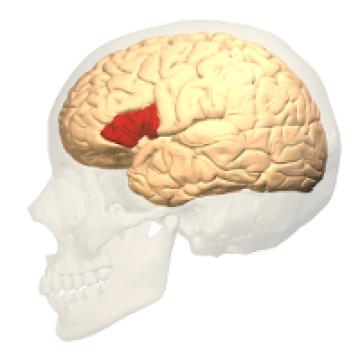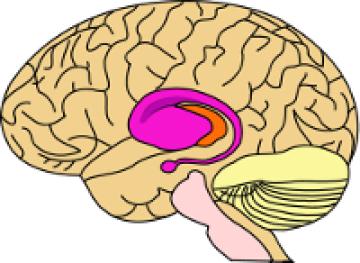The science of stammering
*This article is more than 5 years old*
Norman Miller reviews some of the research that is helping us better understand stammering and its treatment.
(This is an edited version of the article was published in New Scientist, April 2016.)

I pray every day no-one will ask my name. That's not because 'Norman' is so terrible (it's bad, but not terrible). The reason is that I stammer, and the thing you are asked most frequently in life is nearly impossible to get out. Thank God for business cards.
But I'm far from alone. Also called stuttering, stammering affects around 70 million people worldwide, cutting across all boundaries. Every language has a word for it: begaiement (French), tartamudez (Spanish), hakalaanaa (Hindi), hau hick (Cantonese), domori (Japanese), nsu (Nigerian Ibo).
Famous people
Some illustrious folk have stammered throughout history. The Roman Emperor Claudius and Britain's King George VI were just two of the famous rulers, while evidence that Isaac Newton, Charles Darwin and Alan Turing all stammered to varying degrees rather undermines prejudices that it somehow implies lack of intelligence.
Despite his renown as an orator, Winston Churchill was another who battled to deal with a stammer, and a phrase he used to describe Russia - "a riddle wrapped in a mystery inside an enigma" - was borrowed to describe stuttering by Charles Van Riper, a 1930s American researcher who pioneered an early form of treatment based on speech modification.
For most of history, stuttering has been an excuse for mockery, prejudice and misguided 'cures'.
For most of history, though, stuttering has been an excuse for mockery, prejudice and misguided 'cures'. One old belief blamed it on abnormalities of the tongue, leading to cauterisation or cutting the offending' body part. The Greek philosopher Demosthenes, meanwhile, worked on his fluency by shouting at the sea with pebbles in his mouth.
Some more modern ideas weren't much sounder. In the 1950s, US researcher Wendell Johnson blamed stuttering on negative reactions by over-anxious parents to children's normal speech hesitancies – an idea still trotted out despite any real supporting evidence. Psycho-babblers blamed things like 'unresolved pregenital oral sadistic conflict' (no, I haven't a clue either).
Matters weren't helped by the genuine riddles and enigmas stammering presents. For example, while around 5% of children between ages two and five stutter at some point, most just 'grow out of it' - with no discernible pattern as to who or how. More confusingly perhaps, among those who stammer into adulthood, even the most severely affected experience so-called fluency inducing conditions. These include singing, talking in a loud room, talking to oneself or an animal - or putting on a foreign accent!
Understanding stammering
Rather than there being one clear-cut form of stammering, three have been identified. Developmental stuttering is the commonest - and the most widely researched - appearing in young children and for the unlucky 1% of the global population for whom it remains into adulthood. Neurogenic stuttering, by contrast, develops as a result of strokes or other brain traumas. Psychogenic stuttering is a rare form that arises after severe emotional trauma.
To understand what might be going wrong in stammering, consider what goes right in fluency. Normal speech is produced via a series of precisely coordinated muscle movements involving breathing, phonation (voice production) and articulation (movement of the throat, palate, tongue, and lips).
This all requires several areas of the brain to co-ordinate things in neat sequence. A region in the frontal cortex controls muscle movement planning and execution, while regions in the temporoparietal cortex handle auditory feedback mechanisms. Parts of the basal ganglia (notably the striatum), thalamus and cerebellum chip in with internal timing and sequencing cues.
So the fluency most people take for granted actually depends on a lot of things combining perfectly. And researchers have now found neural differences between stutterers and fluent speakers that suggest the problem lies in a breakdown in this highly co-ordinated planning and execution of speech elements.
The fluency most people take for granted actually depends on a lot of things combining perfectly.
Looking at the brain
"There is something fundamentally different about the brains of people who stutter," says Scott Grafton, a neuroscientist at the University of California Santa Barbara. Working with colleague Roger Ingham, diffusion spectrum imaging (DSI) in an MRI scanner was used to map the complex tangle of neural intersections used during speech production by stammerers of various ages and both genders.
What appeared was an abnormality in a region known as the arcuate fasciculus. This bundle of nerve fibres provides a communication conduit for signals between parts of the rear brain to parts of the front brain known to be involved in speech production. And normally, the neural 'wiring' in the arcuate fasciculus splits into several branches at the rear of the brain. "What's interesting is the back half", says Grafton. "In the vast majority of the stutterers we scanned, there seems to be a missing branch of neural connections," says Grafton.

One brain region linked into a speech production network by the arcuate fasciculus is Broca's area (pictured), which is involved in directing muscle movement of the mouth when you form words. The fact that children who stammer also show disorganised neural connections in Broca's area suggests this may be another key player in the stammering equation.
Another area now implicated in stammering is the striatum (pictured), a part of the brain located in the basal ganglia which plays a key role in facilitating voluntary movement.

The basal ganglia receives information about a desired goal – such as producing speech - from the cerebral cortex, and helps to achieve that goal by selecting the appropriate physiological actions and initiating movement of relevant bodily parts to produce a smooth, fluid result. Various studies suggest malfunctions in the striatum may be yet another element in stuttering.
At Oxford University's Department of Experimental Psychology, Kate Watkins and Jen Chesters found further neural abnormalities in both adult and child stutterers, using diffusion tensor imaging (DTI) and functional MRI. "We found differences in the white matter underneath the ventral premotor cortex, which is connected to the arcuate fasciculus," says Watkins. "But we found differences in the arcuate fasciculus too."
Soo-Eun Chang at the University of Michigan, meanwhile, has carried out brain scans of stuttering children as young as three (no easy task due to youthful fidgetiness). She found reduced grey matter volumes in speech relevant regions, as well as stunted white matter connectivity in regions associated with auditory-motor activity. Chang's suggestion is that these regions develop differently in stuttering children, affecting their ability to plan and execute fluent speech processes.
These studies increasingly hint that people who stammer do so because of connection faults in the speech-producing networks of their brain.
These studies increasingly hint that people who stammer do so because of connection faults in the speech-producing networks of their brain. However, the elephant in the room is whether these anomalies in the brain cause the stutter or whether 'natural' dysfluencies in early childhood create the anomalies in the developing brains of children who go on to stammer.
Kate Watkins admits that, at present, scientists simply cannot yet answer this chicken-and-egg conundrum. "The differences are there in young children close to the time that stammering starts, but most of the data acquired has been from adults who have stammered all their lives. So it is absolutely the case that stammering could cause the brain anomalies." The only way to solve this mystery would be longitudinal studies over years or decades.
Recovered stammerers
Another previous mystery is, however, starting to be unravelled, involving scans of stammerers who have overcome the condition. Christian Kell at the Frankfurt Brain Imaging Centre in Germany has led the way in comparing the brain function of persistent stammerers compared to so-called 'recovered stammerers'.
Among fluent speakers it is areas in the left hemisphere of the brain that take the dominant role in speech production. In persistent stammerers, however, their right hemispheres activate more strongly when speaking, even when they are fluent. For Kell, this suggests their brains are attempting to find some way to compensate for malfunctions in the relevant left hemisphere speech areas. "To some degree, this could reduce symptoms - but only partly, because the right hemisphere usually is not specialised in speaking," he says.
Unlike fluent speakers, in persistent stammerers their right hemispheres activate more strongly when speaking, even when they are fluent.
Among recovered stammerers, however, Kell found left hemisphere networks were brought back into play. He identified one particular neural fix in an area known as Brodmann Area 47, or BA47, that is known to be linked to various speech mechanisms including phonological processing. In persistent stutterers, scans show BA47 as one of the areas failing to activate properly - but among recovered stammerers it appears to be working again. "But I am pretty sure recovery does not involve neurogenesis - growth of new neurons - but rather plastic adaptive changes in neural networks."
This kind of plasticity could also help explain the fact that four times as many boys as girls seem to stutter. Soo-Eun Chang at the University of Michigan who studies stammering in children suggests that girls' brains may have a greater plasticity which allows them to adapt better. "There is some evidence that girls who stutter may have better connectivity in certain brain networks that help coordinate between auditory and motor areas of the brain, which may help them more able to recover."
But if stuttering is caused by anomalies in brain structure, what causes those anomalies in the first place? Twin studies show a strong genetic element, but it's not the whole answer.
Gene genie?
In the hunt for specific 'stammering genes', Dennis Drayna at the National Institute of Health in the US is focusing on families with multiple stammerers - including one extended Cameroonian family with over 40 stammerers and several families in Pakistan, where the tradition of marriages between cousins would amplify the impact of such genes.
In one analysis of the DNA of nearly 400 people who stammer, matched with a similar sized fluent control group, he found three gene mutations that appeared repeatedly among the stutterers.
These genes encode an enzyme that breaks down and recycles cellular components. Drayna believes that the gene mutations he identified in stammerers could cause a breakdown in the healthy recycling of cells in areas of the brain related to speech processing, resulting in the sort of anomalies – such as missing neural connections – observed in areas like the arcuate fasciculus. Drayna envisions a future where those found to have these gene mutations might receive enzyme replacement therapy that could treat the problem.
Treatments
By peering inside the brains of people who stammer, brain imaging techniques are also offering hope for more scientific treatments. One old school treatment developed in the 1960s involves 'masking devices' which feed white noise into the ears of stammerers as they try to speak, based on the idea that stammerers often become more fluent when they can't hear themselves clearly. A classic example of this was cited by Charles Van Riper in his 1982 book The Nature Of Stuttering when he described a persistent stammerer who became fluent almost immediately after an accident that made him completely deaf. "The cessation of stuttering occurred within three hours of the trauma," wrote Van Riper.
Watkins and her team used MRI scans to find out why this might work. They found that during speech production, activity in the motor and auditory areas of the brains of people who stutter was out of sync, but devices that blocked auditory feedback as stutterers spoke seemed to make the relevant neural activity get more in sync. The Oxford research builds on research in 2010 by Oren Civier at The Leslie and Susan Gonda Multidisciplinary Brain Research Center in Israel which also pointed to a malfunction in the how the brains of stammerers handle auditory feedback as they try to speak.
(Web Editor's note: a related approach is altered auditory feedback, where speech is played back with a small delay and/or at a different pitch. See our Apps & Devices page)
Activity in the motor and auditory areas of the brains of people who stutter was out of sync
At UCSB, they have enjoyed some success with a technique called MPI (Modifying Phonation Intervals). Phonation intervals are the periods of time vocal folds vibrate to produce vowels and voiced consonants, delineated by voiceless consonants and pauses. Roger Ingham found that intensive training in modifying PIs gave stammerers fluency. There are inspiring before/after videos on this Youtube link.
To compare MPI to other treatments, the UCSB team assigned 17 adult stammerers to MPI therapy, and 10 others to another method called prolonged speech (fluency shaping) therapy, where speech is slowed down to almost a drawl. While 11 of the 17 MPI participants became fluent, just three of the prolonged speech group did. Brain imaging studies showed MPI to be associated with decreased activity in the putamen area of the brain for those who became fluent – a neural region associated with phonation, motor learning and control.
Drug therapies
Others have sought a magic pill to treat stammering - often looking at drugs already used to treat other conditions. Early results were mixed. Anti-anxiety drugs like alprazolam (aka Xanax) and citalopram (Celexa) reduced stuttering in some patients – but had no effect on most. Haloperidol – a drug used to treat conditions like Tourette's that often include speech problems - also showed some promise in inducing fluency, but came with severe side effects.
Another avenue focused on drugs that block the brain chemical dopamine, inspired by the discovery that some fluent speakers treated with dopamine boosters for other conditions then acquired a stutter. The dopamine blocker risperidone - more commonly used to treat bipolar conditions – was one drug that produced improved fluency in many stammerers, with PET brain scans showing raised activity in speech-associated areas like the striatum in the basal ganglia.
Between 2008-2011, meanwhile, neuroscientist Gerald Maguire conducted studies of pagoclone – an anti-anxiety drug that targets a brain chemical known as GABA – which suggested it brought on significantly improved fluency in around 55% of stutterers, with minimal side effects. However, funding issues led to research on the drug grinding to a halt. (Web Editor's note: see also Pagoclone – disappointing news.)
Maguire holds a specially endowed chair in stuttering research at University of California Riverside School of Medicine, and as a lifelong stammerer has chosen to try various potential drug treatments on himself. He believes dopamine blockers are the likeliest candidates as anti-stuttering medication. "Every study completed of a dopamine antagonist has shown positive benefit," says Maguire. "Dopamine medications result in a more natural speech by improving the function of the striatum. We become fluent when we sing because we bypass the defective striatum."
Gerald Maguire's money is now on asenapine.
His money, though, is now on asenapine - a drug already approved to treat people with bipolar disorder and schizophrenia. After taking it for nearly a year, Maguire put a figure of 80% on the reduction in his own stutter, and he is now helping conduct Phase IV US trials.
Kate Watkins is holding fire on prospects for anti-stammering drug treatments. "I think the scientific theories that implicate dopamine are persuasive - but the evidence from brain imaging studies is not particularly clear with respect to either dopamine or GABA."
USCB's Roger Ingham is also wary. He concedes that several studies found dopamine levels in the brains of stammerers 50-200% higher than fluent controls, but criticises the number of subjects used – just three stutterers in one paper - as being too low to draw firm conclusions.
But at least stammering is finally getting the serious research it deserves. And perhaps before today's 70 million who stammer are replaced by the next wave of people with this age-old condition, we may have not just an explanation of this riddle wrapped in a mystery inside an enigma, but also a solution. Then maybe I can finally say my name with confidence.
This article was first published on our old website on 12th April 2016.






























